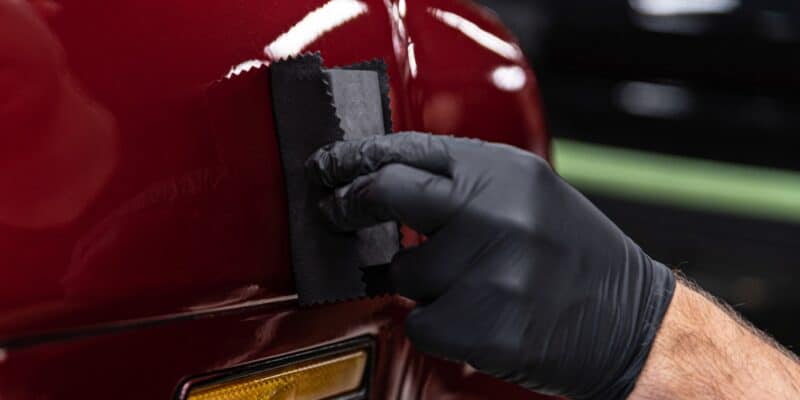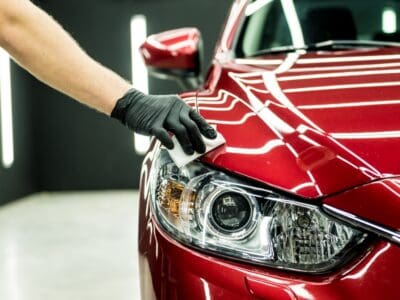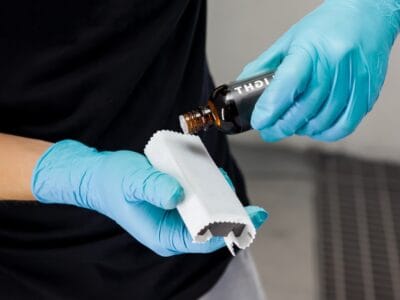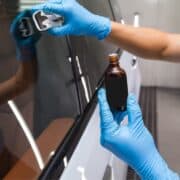
Ceramic coatings have become increasingly popular in the world of car detailing. They are considered the ultimate protection for a car’s paintwork. But what exactly is this substance, how does it work, and what can you expect from the best ceramic coating products? Keep reading to find out.
What Is Ceramic Coating for Cars?
Ceramic coating for cars is a clear liquid that is applied to a car’s exterior to protect the paintwork from environmental elements. It creates a permanent bond with the surface, forming a protective layer that is resistant to UV rays, chemicals, and scratches.
The Science Behind Ceramic Coatings
Ceramic coatings are made up of silicon dioxide (SiO2), titanium dioxide (TiO2), and other proprietary polymers that create a strong bond with the paint surface. When applied to a car’s exterior, the ceramic coating chemically bonds with the paintwork, creating a layer of protection that is several times thicker than wax or sealants. This makes it hard and durable, allowing it to withstand extreme temperatures and harsh weather conditions.
Types of Ceramic Coatings
There are three main types of ceramic coatings: professional grade, budget, and sprayable ceramic coatings.
Professional Grade Ceramic Coatings
Professional grade ceramic coatings are the most durable and long-lasting ceramic coatings on the market. They offer the highest protection level against environmental elements and are designed to last for years. They are often used by professional detailers. Oftentimes, manufacturers only sell these to pros.
Budget Ceramic Coatings
Budget ceramic coatings are more affordable than professional-grade coatings but still offer excellent protection for your car’s paintwork. They are more DIY-friendly. But even then, you need to be careful when using them.
Sprayable Ceramic Coatings
Sprayable ceramic coatings are a relatively new development in the world of ceramic coatings. They are designed to be easy to apply and can be sprayed on using a spray gun or a simple spray bottle. Sprayable coatings are less durable than professional-grade coatings, but they are still an excellent option for those who want to protect their car’s paintwork without spending a lot of money.
Benefits of Ceramic Coating
Ceramic coating has become increasingly popular among car owners and for good reason. A ceramic coat has several benefits for your vehicle, including protection from environmental elements such as UV rays, chemicals, and contaminants.
It also offers hydrophobic properties that repel water and prevent dirt and debris from sticking to your car’s surface. This means that your car will require less frequent washing, making maintenance more comfortable and less time-consuming.
Another significant benefit of ceramic coating is its ability to enhance the appearance of your vehicle. A ceramic coating gives your car a shiny finish that lasts longer than wax or sealant. It also offers a higher level of scratch resistance, ensuring your car maintains its new look for an extended period.
What Ceramic Coating Won’t Do
While ceramic coating offers numerous benefits, it is essential to understand its limitations. A ceramic coat won’t prevent rock chips or dings from damaging your car’s paint. Also, it won’t repair existing scratches or swirl marks on your car’s surface.
Ceramic coating is not a substitute for regular maintenance and cleaning. It is only a protective layer that makes cleaning and maintaining your vehicle easier. See our top 15 ceramic coating myths for more.
How Much Does Ceramic Coating Cost?
The cost of a ceramic coat varies depending on several factors, such as the size of your vehicle, the type of ceramic coating you choose, and the level of paint correction and overall preparation the car will need.
You can expect professional-grade ceramic coating service to cost anywhere from $300 to $3,000. If you’re going the DIY route, you’ll find budget ceramic coatings for as low as $50—they usually do not have the same durability as professional-grade coatings, though.
How to DIY Ceramic Coat Your Vehicle
DIY ceramic coating is possible, but it requires careful preparation and application. See our detailed guide on the whole process.
In summary, start by thoroughly washing and drying your car to remove contaminants. Next, use a clay bar to remove any embedded dirt or grime that won’t come off with a simple wash. Then, apply the ceramic coating using a foam applicator pad, working in small sections to ensure complete coverage. Allow the coating to dry for at least 24 hours before exposing your car to water or other elements.
Is Ceramic Coating Worth It?
Whether a ceramic coating is worth it or not depends on your priorities and needs. If you want to protect your car’s paint from environmental damage and make maintenance easier, ceramic coating is an excellent investment. It can help keep the value of your vehicle over time and enhance its overall appearance.
What About Graphene Coatings?
Graphene coatings are the latest development in ceramic coating technology, offering even greater protection and durability than traditional ceramic coatings. Graphene coatings are more expensive than standard ceramic coatings, but they also offer superior protection against UV rays, chemicals, and other environmental elements.
Graphene coatings also offer self-cleaning properties, making maintenance even more comfortable. However, like ceramic coatings, graphene coatings won’t prevent rock chips or dings from damaging your car’s paint.
Conclusion
Ceramic coatings are an excellent way to protect your car’s paintwork and keep it looking great for years to come. Whether you choose a professional-grade, budget, or sprayable ceramic coating, the benefits of ceramic coatings are undeniable. If you want to give your car the ultimate protection, consider investing.
















